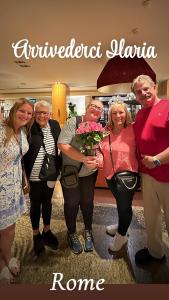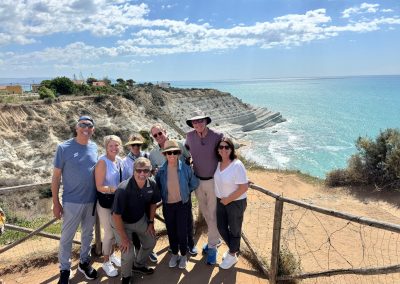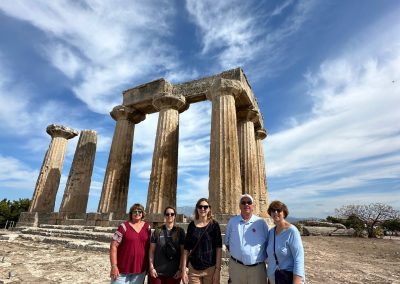
Exploring Beyond Europe: New Destinations, New Adventures!

For almost fifty years, my heart has belonged to Europe—until a single sunset in the Serengeti changed everything.
I’d spent nearly five decades leading tours through cobblestone streets and medieval castles, convinced I’d seen it all. But as I grew older, I realized there was a finite number of days left on this Earth, so we’d better experience all we can while we can. That’s how I found myself standing in a Toyota Land Cruiser, camera in hand, marveling at a herd of giraffes gliding across a brilliant orange Serengeti sunset—about as far from a Tuscan hill town as you can imagine.
Europe will always be my choice destination. I’ve spent 48 years showing folks like you around my favorite European places. I still cherish those jokes that I’ll lead tours when I’m 90, encouraging my group to “move along; it’s just another 10-minute walk.” But something shifted in me that day in Tanzania. I realized there’s a whole world of wonder waiting beyond the familiar.
Why Go Beyond Europe?
Like I said, “I’m not getting any younger.” That’s why I’ve crafted my Exploring Beyond Europe series—small-group tours that take you to places where the culture, landscape, and wildlife are unlike anything you’ll find in the USA or Europe.
If you’re feeling that same restlessness, that whisper asking “what else is out there?”—you’re exactly who these journeys are for.
Our adventures in Ecuador and the Galápagos Islands are a perfect example: think volcanic islands with blue-footed boobies, giant tortoises lumbering through misty highlands, and snorkeling with playful sea lions. These trips are designed with the same spirit as our European tours—immersive, authentic, and always focused on connecting you with local people and experiences.

What Makes These Journeys Special?
Just like our European itineraries, these Exploring Beyond Europe trips are all about small groups, personal guidance, and immersive local experiences. We work with trusted guides, stay in locally owned lodges, charter boats owned by our friends, and make sure every day is packed with opportunities to learn, taste, and explore. It’s travel that’s both adventurous and comfortable—always in the McGuffin style!
Here’s what sets our adventures apart:
Small group sizes (only 12 people) mean more flexibility and camaraderie—you’ll actually get to know your fellow travelers, and we can pivot when we discover a hidden gem or local festival. Personal guidance from me and our expert local partners ensures you’re not just another face in a tour bus; you’re part of a curated experience shaped by decades of travel wisdom. And authentic experiences are at the heart of everything we do—from home-cooked meals in Andean villages and photo hunting for wild game in Tanzania, to hikes through cloud forests where your guide grew up.
On a recent Safari tour, we were sitting around the dinner table recalling our adventures the last few days. Everyone shared their highlight, their wow moment, they were all different, yet the same… Roy shared, “For years I’d dreamed of going on a safari to experience the animals in the wild, I’ve enjoyed every moment and now I can tick this off my bucket list.”
Travel Tips for New Frontiers
Stepping outside your comfort zone doesn’t mean sacrificing comfort or safety. Here’s what I’ve learned from taking European travelers to new continents:
Pack layers, not suitcases. Climate varies dramatically—from chilly morning game drives to hot afternoon hikes. Lightweight, breathable layers work everywhere from the Galápagos to the Serengeti.
Embrace local rhythms. Unlike Europe’s predictable schedules, many destinations operate on “island time” or “safari time.” This isn’t inefficiency; it’s a different relationship with life. Go with it, and you’ll find yourself more relaxed than you’ve been in years.
Say yes to the unfamiliar. That guinea pig dish in Peru? The fermented tea in the Himalayas? Some of my best travel memories come from saying yes when my instinct was to politely decline.
Trust the expertise. Our local guides know these places intimately—where to find the best light for photos, which trails are less crowded, when the sea lions are most playful. Listen to them, and you’ll have experiences other tourists miss entirely.
Ready for Your Next Adventure?
 Europe will always hold a special place in my heart—and in our tour calendar. But life is short, and the world is vast and waiting. Whether it’s watching a leopard lounge in an acacia tree, snorkeling alongside sea turtles older than most European cathedrals, or sharing stories around a campfire under the Southern Cross, these new adventures offer something your soul didn’t even know it was craving.
Europe will always hold a special place in my heart—and in our tour calendar. But life is short, and the world is vast and waiting. Whether it’s watching a leopard lounge in an acacia tree, snorkeling alongside sea turtles older than most European cathedrals, or sharing stories around a campfire under the Southern Cross, these new adventures offer something your soul didn’t even know it was craving.
I’ve spent 48 years perfecting the art of small-group travel. Now I’m taking everything I’ve learned and applying it to the rest of the world. Join me, and let’s explore beyond Europe together.
Browse our upcoming Exploring Beyond Europe itineraries, or reach out to chat about which adventure might be calling your name. Trust me—that sunset in the Serengeti is waiting for you too.


































